1 of 11
Download to read offline



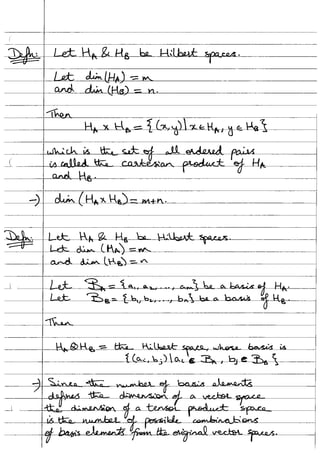
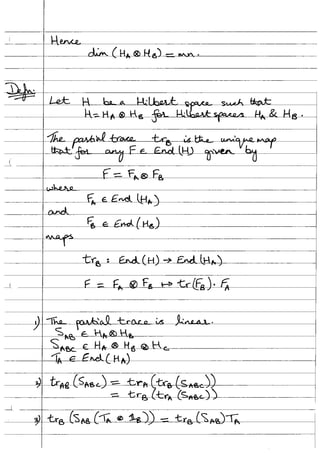


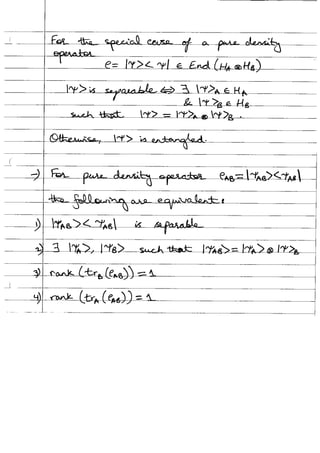
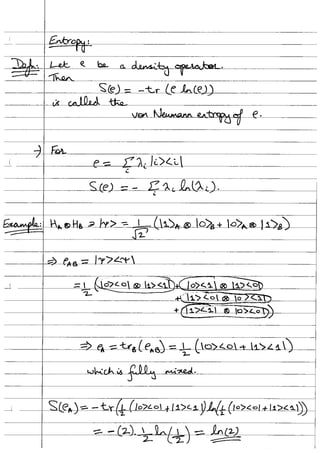
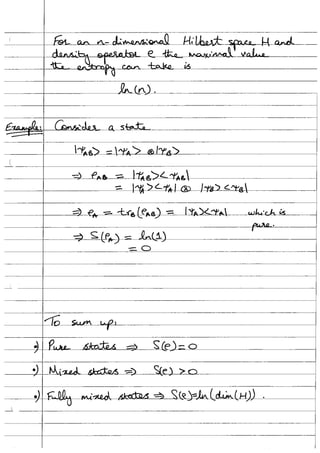

Ad
Recommended
BrownianMotion
BrownianMotionJohar M. Ashfaque
╠²
The document defines and provides examples of standard Brownian motion and Brownian bridge processes.
Standard Brownian motion is a random process with stationary and independent increments that is normally distributed with mean 0 and variance equal to time. A Brownian bridge restricts standard Brownian motion to the interval [0,1] and conditions it to be 0 at both endpoints, forming a "bridge". The Brownian bridge is a continuous Gaussian process with mean 0 and covariance that depends on the minimum and product of times. An example shows how a Brownian bridge can be constructed from a standard Brownian motion.Probable
ProbableJohar M. Ashfaque
╠²
1. A random variable (RV) is a function that maps outcomes of a random phenomenon to numerical values. For a function X to be an RV, the set P(x) = {Žē: X(Žē) Ōēż x} must be an event with a well-defined probability P for any x.
2. Conditional probability P(A|B) is the probability of event A occurring given that event B has occurred. It is defined as P(A Ōł® B)/P(B).
3. The law of total probability states that for mutually exclusive and exhaustive events B1, B2, ..., the probability of event A is the sum of the probabilities of A given each Bi multiplied byClassificationofStates
ClassificationofStatesJohar M. Ashfaque
╠²
This document discusses classification of states in Markov chains. It defines recurrent and transient states. A state is recurrent if it is accessible from all other states in its class. A recurrent class forms when all states within it are recurrent. The document also discusses properties of recurrent and transient states, including that recurrent states will be visited an infinite number of times once entered, and that if the initial state is transient, eventually only recurrent states from the same class will be visited. It concludes by defining periodic and aperiodic recurrent classes.YRM 2016 - JM ASHFAQUE
YRM 2016 - JM ASHFAQUEJohar M. Ashfaque
╠²
This document discusses how F-theory geometric engineering can be used to build GUT models with realistic phenomenology. It describes how compactifying F-theory on an elliptic Calabi-Yau four-fold allows for localized gauge groups and matter curves that can realize Grand Unified Theories like SU(5). Key elements like Yukawa points emerge from the geometry. Breaking of the GUT group is also possible using Abelian fluxes. Recent LHC diphoton excess could potentially be explained by particles in the 10 representation of SO(10) emerging in F-theory GUTs.JM ASHFAQUE
JM ASHFAQUEJohar M. Ashfaque
╠²
This document discusses F-theory models that could explain the LHC diphoton excess. It explores subgroups of the E6 gauge group in F-theory models and their connection to phenomenology. Specific F-theory model building elements like gauge fluxes are discussed as they relate to subgroups like SU(5) and the embedding of the Standard Model gauge group. Vector-like representations from the 10 of SO(10) that contribute to the diphoton signal are highlighted. The work aims to search for left-right symmetric models within F-theory and explore the connection between F-theory phenomenology and the LHC diphoton excess.WhyStrings
WhyStringsJohar M. Ashfaque
╠²
String theory offers a solution to the problem of quantizing gravity by describing particles like gravitons. It provides a unified description of all fundamental forces and is a finite theory that does not generate divergences. String theory also suggests deeper connections between string and gauge theories through dualities, where some gauge theories are equivalent to particular string theories and vice versa.TLT
TLTJohar M. Ashfaque
╠²
This document provides a summary of the Laplace transform. It begins with an introduction discussing the history and importance of the Laplace transform. Section 2 defines the Laplace transform and provides examples of taking the Laplace transform of common functions like e-at and sin(Žēt). Section 3 outlines important properties of the Laplace transform including linearity, derivatives, shifts, and scaling. Several examples are worked through to demonstrate these properties. Section 4 discusses conditions for the Laplace transform to exist. Section 5 introduces the convolution theorem. Section 6 discusses using the Laplace transform to solve ordinary differential equations and systems of differential equations, providing examples.JM ASHFAQUE
JM ASHFAQUEJohar M. Ashfaque
╠²
This document summarizes research into non-supersymmetric heterotic string vacua that resemble the MSSM. The researchers sought models with 4D N=1 supersymmetry that break to N=0, containing the standard model gauge group and 3 generations of quarks and leptons. They presented an explicit tachyon-free model constructed from a set of boundary condition basis vectors without supersymmetry. This model separates the observable and hidden sectors as SO(10) and SO(16) respectively, and breaks to the standard model gauge group and additional U(1) factors. Future work aims to search for models with exponentially suppressed cosmological constants and cancellation of vacuum energy tadpoles.YRM 2015 - JM ASHFAQUE
YRM 2015 - JM ASHFAQUEJohar M. Ashfaque
╠²
The document discusses semi-realistic non-supersymmetric heterotic string vacua. It seeks string models that closely resemble the MSSM with 4D N=1 theory, containing the standard model gauge group, 3 generations of quarks and leptons, and a minimum of one Higgs doublet pair. An explicit non-supersymmetric tachyon-free model is presented, with basis vectors that break N=1 supersymmetry to N=0, resulting in a left-right symmetric SO(10) observable sector and a hidden sector containing multiple U(1) and SU(3) factors.PCCG- JM ASHFAQUE
PCCG- JM ASHFAQUEJohar M. Ashfaque
╠²
The document summarizes a talk on string geometry given by Johar M. Ashfaque at a postgraduate conference in complex geometry. The talk aimed to show how geometry has played a key role in string theory and highlight various connections. It covered topics like Calabi-Yau manifolds, orbifolds, heterotic strings, and how internal geometry in string compactification determines the 4D effective field theory.JM ASHFAQUE
JM ASHFAQUEJohar M. Ashfaque
╠²
This document summarizes research into non-supersymmetric heterotic string vacua that resemble the MSSM. The researchers sought models with 4D N=1 supersymmetry that break to N=0, containing the standard model gauge group and 3 generations of quarks and leptons. They presented an explicit tachyon-free model constructed from fermionic strings using a set of boundary condition basis vectors and GGSO phases. This model separates the observable and hidden sectors but contains a mismatch between fermion and boson numbers requiring future work to cancel the vacuum energy.What Is The Strong CP Problem
What Is The Strong CP ProblemJohar M. Ashfaque
╠²
The document discusses the strong CP problem in particle physics. It notes that the Standard Model allows for a CP-violating interaction term that contributes to the neutron electric dipole moment. Current bounds on the neutron EDM require that the strong CP phase ╬Ė be less than 10-10, which is an unnaturally small value given the amount of CP violation seen in the weak interactions. One proposed solution is to add an axion field to the Standard Model through a Peccei-Quinn symmetry, which would generate a pseudo-Goldstone boson called the axion that could explain the smallness of ╬Ė.YTF 2014 - JM ASHFAQUE
YTF 2014 - JM ASHFAQUEJohar M. Ashfaque
╠²
The document discusses whether the strong CP problem can be solved in the free-fermionic string theory setting. It explains that axions are the most promising solution to the strong CP problem and describes how axions arise in string compactifications, with two types of axions present - the model-independent axion and the Peccei-Quinn type axion. It then discusses how the strong CP problem and axion decay constant problem are addressed in the free-fermionic setting, where the global anomalous U(1) gauge symmetry generates a U(1)A axion through spontaneous symmetry breaking via the Dine-Seiberg-Witten mechanism.PGR Workshop 5-minute Talk: Heterotic Strings and Free-Fermionic Construction
PGR Workshop 5-minute Talk: Heterotic Strings and Free-Fermionic ConstructionJohar M. Ashfaque
╠²
This document summarizes a presentation given by Johar M. Ashfaque on heterotic strings and the free-fermionic construction. The presentation was given at the University of Liverpool's string phenomenology group and aimed to briefly outline the free-fermionic construction, highlighting its key points. Specifically, it discussed how the free-fermionic construction is based on heterotic strings with a supersymmetric left-moving sector and bosonic right-moving sector. It also provided an example of the NAHE set, which is a set of basis vectors used in the free-fermionic construction.The First Order Stark Effect In Hydrogen For $n=3$
The First Order Stark Effect In Hydrogen For $n=3$Johar M. Ashfaque
╠²
The document discusses the first order Stark effect in hydrogen for n=3. It shows that for n=3, the degeneracy of the hydrogen energy level is 9. It then sets out to compute the 9x9 matrix for this case. It defines the perturbation produced by an electric field and a general matrix element. It also discusses the radial and angular parts of the integral needed to compute the matrix elements.More Related Content
More from Johar M. Ashfaque (9)
TLT
TLTJohar M. Ashfaque
╠²
This document provides a summary of the Laplace transform. It begins with an introduction discussing the history and importance of the Laplace transform. Section 2 defines the Laplace transform and provides examples of taking the Laplace transform of common functions like e-at and sin(Žēt). Section 3 outlines important properties of the Laplace transform including linearity, derivatives, shifts, and scaling. Several examples are worked through to demonstrate these properties. Section 4 discusses conditions for the Laplace transform to exist. Section 5 introduces the convolution theorem. Section 6 discusses using the Laplace transform to solve ordinary differential equations and systems of differential equations, providing examples.JM ASHFAQUE
JM ASHFAQUEJohar M. Ashfaque
╠²
This document summarizes research into non-supersymmetric heterotic string vacua that resemble the MSSM. The researchers sought models with 4D N=1 supersymmetry that break to N=0, containing the standard model gauge group and 3 generations of quarks and leptons. They presented an explicit tachyon-free model constructed from a set of boundary condition basis vectors without supersymmetry. This model separates the observable and hidden sectors as SO(10) and SO(16) respectively, and breaks to the standard model gauge group and additional U(1) factors. Future work aims to search for models with exponentially suppressed cosmological constants and cancellation of vacuum energy tadpoles.YRM 2015 - JM ASHFAQUE
YRM 2015 - JM ASHFAQUEJohar M. Ashfaque
╠²
The document discusses semi-realistic non-supersymmetric heterotic string vacua. It seeks string models that closely resemble the MSSM with 4D N=1 theory, containing the standard model gauge group, 3 generations of quarks and leptons, and a minimum of one Higgs doublet pair. An explicit non-supersymmetric tachyon-free model is presented, with basis vectors that break N=1 supersymmetry to N=0, resulting in a left-right symmetric SO(10) observable sector and a hidden sector containing multiple U(1) and SU(3) factors.PCCG- JM ASHFAQUE
PCCG- JM ASHFAQUEJohar M. Ashfaque
╠²
The document summarizes a talk on string geometry given by Johar M. Ashfaque at a postgraduate conference in complex geometry. The talk aimed to show how geometry has played a key role in string theory and highlight various connections. It covered topics like Calabi-Yau manifolds, orbifolds, heterotic strings, and how internal geometry in string compactification determines the 4D effective field theory.JM ASHFAQUE
JM ASHFAQUEJohar M. Ashfaque
╠²
This document summarizes research into non-supersymmetric heterotic string vacua that resemble the MSSM. The researchers sought models with 4D N=1 supersymmetry that break to N=0, containing the standard model gauge group and 3 generations of quarks and leptons. They presented an explicit tachyon-free model constructed from fermionic strings using a set of boundary condition basis vectors and GGSO phases. This model separates the observable and hidden sectors but contains a mismatch between fermion and boson numbers requiring future work to cancel the vacuum energy.What Is The Strong CP Problem
What Is The Strong CP ProblemJohar M. Ashfaque
╠²
The document discusses the strong CP problem in particle physics. It notes that the Standard Model allows for a CP-violating interaction term that contributes to the neutron electric dipole moment. Current bounds on the neutron EDM require that the strong CP phase ╬Ė be less than 10-10, which is an unnaturally small value given the amount of CP violation seen in the weak interactions. One proposed solution is to add an axion field to the Standard Model through a Peccei-Quinn symmetry, which would generate a pseudo-Goldstone boson called the axion that could explain the smallness of ╬Ė.YTF 2014 - JM ASHFAQUE
YTF 2014 - JM ASHFAQUEJohar M. Ashfaque
╠²
The document discusses whether the strong CP problem can be solved in the free-fermionic string theory setting. It explains that axions are the most promising solution to the strong CP problem and describes how axions arise in string compactifications, with two types of axions present - the model-independent axion and the Peccei-Quinn type axion. It then discusses how the strong CP problem and axion decay constant problem are addressed in the free-fermionic setting, where the global anomalous U(1) gauge symmetry generates a U(1)A axion through spontaneous symmetry breaking via the Dine-Seiberg-Witten mechanism.PGR Workshop 5-minute Talk: Heterotic Strings and Free-Fermionic Construction
PGR Workshop 5-minute Talk: Heterotic Strings and Free-Fermionic ConstructionJohar M. Ashfaque
╠²
This document summarizes a presentation given by Johar M. Ashfaque on heterotic strings and the free-fermionic construction. The presentation was given at the University of Liverpool's string phenomenology group and aimed to briefly outline the free-fermionic construction, highlighting its key points. Specifically, it discussed how the free-fermionic construction is based on heterotic strings with a supersymmetric left-moving sector and bosonic right-moving sector. It also provided an example of the NAHE set, which is a set of basis vectors used in the free-fermionic construction.The First Order Stark Effect In Hydrogen For $n=3$
The First Order Stark Effect In Hydrogen For $n=3$Johar M. Ashfaque
╠²
The document discusses the first order Stark effect in hydrogen for n=3. It shows that for n=3, the degeneracy of the hydrogen energy level is 9. It then sets out to compute the 9x9 matrix for this case. It defines the perturbation produced by an electric field and a general matrix element. It also discusses the radial and angular parts of the integral needed to compute the matrix elements.